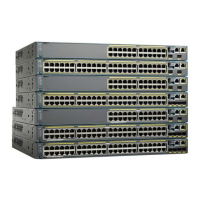shortest path tree (SPT) state from the receivers to the source is maintained, even if the source does not
send traffic for longer periods of time (or even never).
The opposite situation occurs with PIM-SM, where (S, G) state is maintained only if the source is sending
traffic and receivers are joining the group. If a source stops sending traffic for more than 3 minutes in
PIM-SM, the (S, G) state is deleted and only reestablished after packets from the source arrive again
through the RPT (rendezvous point tree). Because no mechanism in PIM-SSM notifies a receiver that
a source is active, the network must maintain the (S, G) state in PIM-SSM as long as receivers are
requesting receipt of that channel.
Information About SSM
The source-specific multicast (SSM) feature is an extension of IP multicast in which datagram traffic is
forwarded to receivers from only those multicast sources that the receivers have explicitly joined. For multicast
groups configured for SSM, only SSM distribution trees (no shared trees) are created.
SSM Components Overview
SSM is a datagram delivery model that best supports one-to-many applications, also known as broadcast
applications. SSM is a core networking technology for the Cisco implementation of IP multicast solutions
targeted for audio and video broadcast application environments. The switch supports the following components
that support SSM implementation:
•
Protocol independent multicast source-specific mode (PIM-SSM)
PIM-SSM is the routing protocol that supports the implementation of SSM and is derived from PIM
sparse mode (PIM-SM).
•
Internet Group Management Protocol version 3 (IGMPv3)
SSM and Internet Standard Multicast (ISM)
The current IP multicast infrastructure in the Internet and many enterprise intranets is based on the PIM-SM
protocol and Multicast Source Discovery Protocol (MSDP). These protocols have the limitations of the Internet
Standard Multicast (ISM) service model. For example, with ISM, the network must maintain knowledge about
which hosts in the network are actively sending multicast traffic.
The ISM service consists of the delivery of IP datagrams from any source to a group of receivers called the
multicast host group. The datagram traffic for the multicast host group consists of datagrams with an arbitrary
IP unicast source address (S) and the multicast group address (G) as the IP destination address. Systems receive
this traffic by becoming members of the host group. Membership in a host group simply requires signaling
the host group through IGMP version 1, 2, or 3.
In SSM, delivery of datagrams is based on (S, G) channels. In both SSM and ISM, no signaling is required
to become a source. However, in SSM, receivers must subscribe or unsubscribe to (S, G) channels to receive
or not receive traffic from specific sources. In other words, receivers can receive traffic only from (S, G)
channels to which they are subscribed, whereas in ISM, receivers need not know the IP addresses of sources
from which they receive their traffic. The proposed standard approach for channel subscription signaling uses
IGMP and includes modes membership reports, which are supported only in IGMP version 3.
Catalyst 2960-XR Switch IP Multicast Routing Configuration Guide, Cisco IOS Release 15.0(2)EX1
OL-29426-01 79
Configuring SSM
Information About SSM

